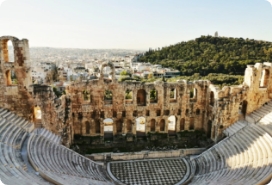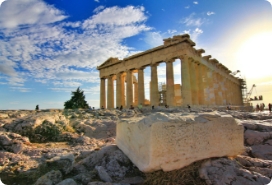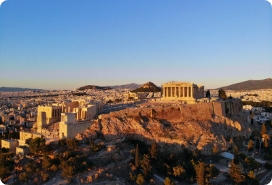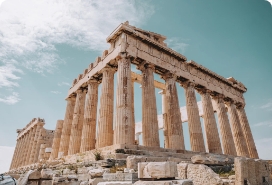Lefkandi
Lefkandi is undoubtedly the most important Early Iron Age site in Greece. The huge apsidal building (the famous “Heroon”) and in general the imported wealth of the entire cemetery in which it is located (Toumba Cemetery) has changed the conception of this period which was previously called the Dark Period. The community that inhabited the settlement was connected over long distances with both the eastern Mediterranean and the western and central Mediterranean. Not only was it a community that imported wealth, but it was also immersed in trade circuits in which it participated as an exporter of grain and/or silver. Thus, the identification of Euboean pottery in the Levant and Cyprus, as well as its influence on pottery in many areas of Greece, attest to the importance of this site for the Protogeometric period.
We should bear in mind that Lefkandi did not begin to trade with the East in the first millennium BC, but that it was an aspect that we could already observe from the end of the 2nd millennium BC in some tombs in the Skoubris cemetery, even showing us Phoenician pottery.
Chronology of studies
Pottery
This section proposes documentation related to ancient pottery and ceramics. This kind of material was one of most common class of artifacts in ancient times and many everyday objects were made of ceramic. Perfume container, fine table ware, crude commercial packing and maritime containers, are different examples of the artifacts presented here.
Data sheets
Coins
Numismatic material is always an interesting source of information. Each mint was a way for a state authority to show its power, as much as a tool for mercantile and day to day transactions. As such, coins distribution do not directly offer evidence of contact, as money always change hands, but some coins series, like bronze minting, are more a proof of travels and possible relationship.
Data sheets
Epigraphy
Texts and writing are clear evidence of the presence of a Phoenician and Punic individual or community: one express and interacts in its language and writings. As such, the presence of Phoenician epigraphy always tells us that an individual from Tyre, Sidon or Carthage was author of the text, or at least mandatory. Bilingual text, in our case translated from Greek or from Phoenician, are evidently even more interesting as they show the existence of a multicultural environment.
Data sheets
Glass
Glass production was distinctly in the beginning a craft originating from the ancient near east, Egypt and the Levant having access then to the sole raw material sources. Phoenician craftsman became expert in producing small containers and jewels, artifacts which rarity made them seen as luxury goods. As time was passing, more and more workshop learnt to use the raw material, but the Phoenician, and their descendants in the western Mediterranean, were expert in this craftsmanship all along the 1rst millennium B.C.
Data sheets
Other material
Many ancient objects could be connected with the Phoenician and Punic population, whether it is stone made of raw material from the Levant, or metal artifacts which raw material sources were directly controlled by the Phoenician, thanks to their control and tin and silver sources of the western Mediterranean. This section consider all the different material evidence which show us the diversity of the contacts between the Hellenic populations of the Aegean and Phoenician and Punic communities.
Data sheets
Pottery
This section proposes documentation related to ancient pottery and ceramics. This kind of material was one of most common class of artifacts in ancient times and many everyday objects were made of ceramic. Perfume container, fine table ware, crude commercial packing and maritime containers, are different examples of the artifacts presented here.
Data sheets
Coins
Numismatic material is always an interesting source of information. Each mint was a way for a state authority to show its power, as much as a tool for mercantile and day to day transactions. As such, coins distribution do not directly offer evidence of contact, as money always change hands, but some coins series, like bronze minting, are more a proof of travels and possible relationship.
Data sheets
Epigraphy
Texts and writing are clear evidence of the presence of a Phoenician and Punic individual or community: one express and interacts in its language and writings. As such, the presence of Phoenician epigraphy always tells us that an individual from Tyre, Sidon or Carthage was author of the text, or at least mandatory. Bilingual text, in our case translated from Greek or from Phoenician, are evidently even more interesting as they show the existence of a multicultural environment.
Data sheets
Glass
Glass production was distinctly in the beginning a craft originating from the ancient near east, Egypt and the Levant having access then to the sole raw material sources. Phoenician craftsman became expert in producing small containers and jewels, artifacts which rarity made them seen as luxury goods. As time was passing, more and more workshop learnt to use the raw material, but the Phoenician, and their descendants in the western Mediterranean, were expert in this craftsmanship all along the 1rst millennium B.C.
Data sheets
Other material
Many ancient objects could be connected with the Phoenician and Punic population, whether it is stone made of raw material from the Levant, or metal artifacts which raw material sources were directly controlled by the Phoenician, thanks to their control and tin and silver sources of the western Mediterranean. This section consider all the different material evidence which show us the diversity of the contacts between the Hellenic populations of the Aegean and Phoenician and Punic communities.
Data sheets
Pottery
This section proposes documentation related to ancient pottery and ceramics. This kind of material was one of most common class of artifacts in ancient times and many everyday objects were made of ceramic. Perfume container, fine table ware, crude commercial packing and maritime containers, are different examples of the artifacts presented here.
Data sheets
Coins
Numismatic material is always an interesting source of information. Each mint was a way for a state authority to show its power, as much as a tool for mercantile and day to day transactions. As such, coins distribution do not directly offer evidence of contact, as money always change hands, but some coins series, like bronze minting, are more a proof of travels and possible relationship.
Data sheets
Epigraphy
Texts and writing are clear evidence of the presence of a Phoenician and Punic individual or community: one express and interacts in its language and writings. As such, the presence of Phoenician epigraphy always tells us that an individual from Tyre, Sidon or Carthage was author of the text, or at least mandatory. Bilingual text, in our case translated from Greek or from Phoenician, are evidently even more interesting as they show the existence of a multicultural environment.
Data sheets
Glass
Glass production was distinctly in the beginning a craft originating from the ancient near east, Egypt and the Levant having access then to the sole raw material sources. Phoenician craftsman became expert in producing small containers and jewels, artifacts which rarity made them seen as luxury goods. As time was passing, more and more workshop learnt to use the raw material, but the Phoenician, and their descendants in the western Mediterranean, were expert in this craftsmanship all along the 1rst millennium B.C.
Data sheets
Other material
Many ancient objects could be connected with the Phoenician and Punic population, whether it is stone made of raw material from the Levant, or metal artifacts which raw material sources were directly controlled by the Phoenician, thanks to their control and tin and silver sources of the western Mediterranean. This section consider all the different material evidence which show us the diversity of the contacts between the Hellenic populations of the Aegean and Phoenician and Punic communities.
Data sheets
Pottery
This section proposes documentation related to ancient pottery and ceramics. This kind of material was one of most common class of artifacts in ancient times and many everyday objects were made of ceramic. Perfume container, fine table ware, crude commercial packing and maritime containers, are different examples of the artifacts presented here.
Data sheets
Coins
Numismatic material is always an interesting source of information. Each mint was a way for a state authority to show its power, as much as a tool for mercantile and day to day transactions. As such, coins distribution do not directly offer evidence of contact, as money always change hands, but some coins series, like bronze minting, are more a proof of travels and possible relationship.
Data sheets
Epigraphy
Texts and writing are clear evidence of the presence of a Phoenician and Punic individual or community: one express and interacts in its language and writings. As such, the presence of Phoenician epigraphy always tells us that an individual from Tyre, Sidon or Carthage was author of the text, or at least mandatory. Bilingual text, in our case translated from Greek or from Phoenician, are evidently even more interesting as they show the existence of a multicultural environment.
Data sheets
Glass
Glass production was distinctly in the beginning a craft originating from the ancient near east, Egypt and the Levant having access then to the sole raw material sources. Phoenician craftsman became expert in producing small containers and jewels, artifacts which rarity made them seen as luxury goods. As time was passing, more and more workshop learnt to use the raw material, but the Phoenician, and their descendants in the western Mediterranean, were expert in this craftsmanship all along the 1rst millennium B.C.
Data sheets
Other material
Many ancient objects could be connected with the Phoenician and Punic population, whether it is stone made of raw material from the Levant, or metal artifacts which raw material sources were directly controlled by the Phoenician, thanks to their control and tin and silver sources of the western Mediterranean. This section consider all the different material evidence which show us the diversity of the contacts between the Hellenic populations of the Aegean and Phoenician and Punic communities.
Data sheets
Pottery
This section proposes documentation related to ancient pottery and ceramics. This kind of material was one of most common class of artifacts in ancient times and many everyday objects were made of ceramic. Perfume container, fine table ware, crude commercial packing and maritime containers, are different examples of the artifacts presented here.
Data sheets
Coins
Numismatic material is always an interesting source of information. Each mint was a way for a state authority to show its power, as much as a tool for mercantile and day to day transactions. As such, coins distribution do not directly offer evidence of contact, as money always change hands, but some coins series, like bronze minting, are more a proof of travels and possible relationship.
Data sheets
Epigraphy
Texts and writing are clear evidence of the presence of a Phoenician and Punic individual or community: one express and interacts in its language and writings. As such, the presence of Phoenician epigraphy always tells us that an individual from Tyre, Sidon or Carthage was author of the text, or at least mandatory. Bilingual text, in our case translated from Greek or from Phoenician, are evidently even more interesting as they show the existence of a multicultural environment.
Data sheets
Glass
Glass production was distinctly in the beginning a craft originating from the ancient near east, Egypt and the Levant having access then to the sole raw material sources. Phoenician craftsman became expert in producing small containers and jewels, artifacts which rarity made them seen as luxury goods. As time was passing, more and more workshop learnt to use the raw material, but the Phoenician, and their descendants in the western Mediterranean, were expert in this craftsmanship all along the 1rst millennium B.C.
Data sheets
Other material
Many ancient objects could be connected with the Phoenician and Punic population, whether it is stone made of raw material from the Levant, or metal artifacts which raw material sources were directly controlled by the Phoenician, thanks to their control and tin and silver sources of the western Mediterranean. This section consider all the different material evidence which show us the diversity of the contacts between the Hellenic populations of the Aegean and Phoenician and Punic communities.
Data sheets
Pottery
This section proposes documentation related to ancient pottery and ceramics. This kind of material was one of most common class of artifacts in ancient times and many everyday objects were made of ceramic. Perfume container, fine table ware, crude commercial packing and maritime containers, are different examples of the artifacts presented here.
Data sheets
Coins
Numismatic material is always an interesting source of information. Each mint was a way for a state authority to show its power, as much as a tool for mercantile and day to day transactions. As such, coins distribution do not directly offer evidence of contact, as money always change hands, but some coins series, like bronze minting, are more a proof of travels and possible relationship.
Data sheets
Epigraphy
Texts and writing are clear evidence of the presence of a Phoenician and Punic individual or community: one express and interacts in its language and writings. As such, the presence of Phoenician epigraphy always tells us that an individual from Tyre, Sidon or Carthage was author of the text, or at least mandatory. Bilingual text, in our case translated from Greek or from Phoenician, are evidently even more interesting as they show the existence of a multicultural environment.
Data sheets
Glass
Glass production was distinctly in the beginning a craft originating from the ancient near east, Egypt and the Levant having access then to the sole raw material sources. Phoenician craftsman became expert in producing small containers and jewels, artifacts which rarity made them seen as luxury goods. As time was passing, more and more workshop learnt to use the raw material, but the Phoenician, and their descendants in the western Mediterranean, were expert in this craftsmanship all along the 1rst millennium B.C.
Data sheets
Other material
Many ancient objects could be connected with the Phoenician and Punic population, whether it is stone made of raw material from the Levant, or metal artifacts which raw material sources were directly controlled by the Phoenician, thanks to their control and tin and silver sources of the western Mediterranean. This section consider all the different material evidence which show us the diversity of the contacts between the Hellenic populations of the Aegean and Phoenician and Punic communities.
Data sheets
Pottery
Lorem ipsum dolor sit amet, consectetur adipiscing elit. Vivamus eleifend velit vel augue tincidunt feugiat. Duis risus quam, pharetra id arcu laoreet, tincidunt egestas ex. Nullam luctus augue id enim maximus, at maximus nibh sagittis. Curabitur in massa varius, maximus odio ac, fringilla tortor.
Data sheets
Coins
Lorem ipsum dolor sit amet, consectetur adipiscing elit. Vivamus eleifend velit vel augue tincidunt feugiat. Duis risus quam, pharetra id arcu laoreet, tincidunt egestas ex. Nullam luctus augue id enim maximus, at maximus nibh sagittis. Curabitur in massa varius, maximus odio ac, fringilla tortor.
Data sheets
Epigraphy
Lorem ipsum dolor sit amet, consectetur adipiscing elit. Vivamus eleifend velit vel augue tincidunt feugiat. Duis risus quam, pharetra id arcu laoreet, tincidunt egestas ex. Nullam luctus augue id enim maximus, at maximus nibh sagittis. Curabitur in massa varius, maximus odio ac, fringilla tortor.
Data sheets
Glass
Lorem ipsum dolor sit amet, consectetur adipiscing elit. Vivamus eleifend velit vel augue tincidunt feugiat. Duis risus quam, pharetra id arcu laoreet, tincidunt egestas ex. Nullam luctus augue id enim maximus, at maximus nibh sagittis. Curabitur in massa varius, maximus odio ac, fringilla tortor.
Data sheets
Other material
Lorem ipsum dolor sit amet, consectetur adipiscing elit. Vivamus eleifend velit vel augue tincidunt feugiat. Duis risus quam, pharetra id arcu laoreet, tincidunt egestas ex. Nullam luctus augue id enim maximus, at maximus nibh sagittis. Curabitur in massa varius, maximus odio ac, fringilla tortor.






